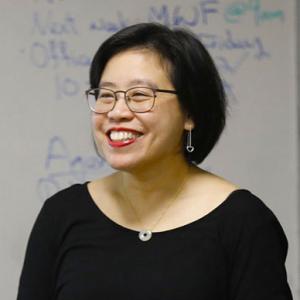
Breaking the isolation
The Disability Staff and Faculty Association, organized just last year at all three UW campuses, has been working to raise awareness and provide support for faculty and staff who may identify as disabled on some level. For Dr. Michelle Garner, associate professor in the School of Social Work & Criminal Justice, who helped establish the affinity group at UW, it’s a dream realized.
“We’re very excited to be here, and we’re also very conscious that disability continues to struggle around stigmatized identity,” she said. Garner is part of the leadership group of the DSFA, and serves on the group’s employee support committee, as well as a change-making committee.
“If we want that to change, we really need allies. You don’t necessarily have any disability or neuro-divergence or mental health issues if you’re hanging out in our group and in this space. You might have family members or friends, or you’re otherwise compelled to show up, learn and be a good colleague and promote better inclusivity for everybody.”
Garner said she’s proud of UW Tacoma for the work it does highlighting people's histories or identities that may need to be addressed to support their academic careers. “A lot of that is finding people that can relate, and kind of breaking the isolation,” she said. “So this is focused on the staff and faculty side of it because if we do that, and make it a good work environment for people that identify with disabilities, chronic health concerns or neuro-divergence, our students are then surrounded by folks who are getting better help and support themselves. And we cultivate an environment that has more understanding and ability to react to and support students who may have disabilities, making UWT a better place for more people.”
According to the National Center for Education Statistics, approximately 15 percent of high school graduates identify as disabled in one way or another. Garner said it concerns her that many of these students who require accommodations in high school, don’t necessarily receive accommodations when they reach college.
“National evidence suggests that some of those students need renewed testing, or that there are expenses that pose a kind of gateway barrier,” she said. “Some of it is they don’t necessarily realize the small changes and how things were handled for them in high school were the best pathway to learning and were critical to their success. So, they don’t know how to advocate for themselves at college, where that could make a difference to them.”
The DSFA marked National Disability Employment Awareness Month in October by doing a virtual screening of the film, The Ride Ahead, a story about a disabled young man who wants to move out and start a career but has no idea where to get the support he needs to do it. The film was virtually screened at all three UW campuses. The film highlights how proper support can provide a pathway to success.
One method of support is simply to include people with disabilities in the daily plans of each class — or each office — so that it’s just a regular part of how a class operates. The method is known as ‘universal design,’ and it’s considered the most inclusive way to get everyone in a community of learners or workers involved.
“There’s a move and a trend toward thinking about universal design,” said Garner. “What are the usual types of things that are included in student disability accommodations, and how can we just build that in?”
Garner said that in the academic setting, universal design includes things like more flexibility about deadlines, and not having as many time-driven projects and assignments. It also means thinking about different kinds of needs, she said. “So, some may do better with conversation, or they may work better with music, etc. It could be as simple as allowing some students to wear headphones, because that actually helps them to concentrate, not because they’re tuning out.”
While the DSFA is specifically for faculty and staff, Garner eventually wants to see a group aimed at students as well. People with invisible disabilities report that they struggle with fitting in at a far higher rate than those with no disabilities or even those with visible disabilities, she notes.
“That speaks to not having a culture of anticipating or being accepting of people with disabilities. The premise behind neurodiversity is that it’s more normal in nature to have different kinds of brains that process in different ways. It’s probably protective of the species.”
Additional resources
-
For an overview of Universal Design in schools, go to: https://www.washington.edu/doit/equal-access-universal-design-instruction
-
For initiating ADA (Americans with Disabilities Act) for UW Employees, go to: https://hr.uw.edu/dso/wp-content/uploads/sites/6/2023/10/managers-role-disability-accommodati-a11y.pdf
-
And, the National Job Accommodation Network has a video aimed at helping people navigate the transition from high school to post-secondary education or the workforce https://www.youtube.com/watch?v=lfPmpGwyM58



